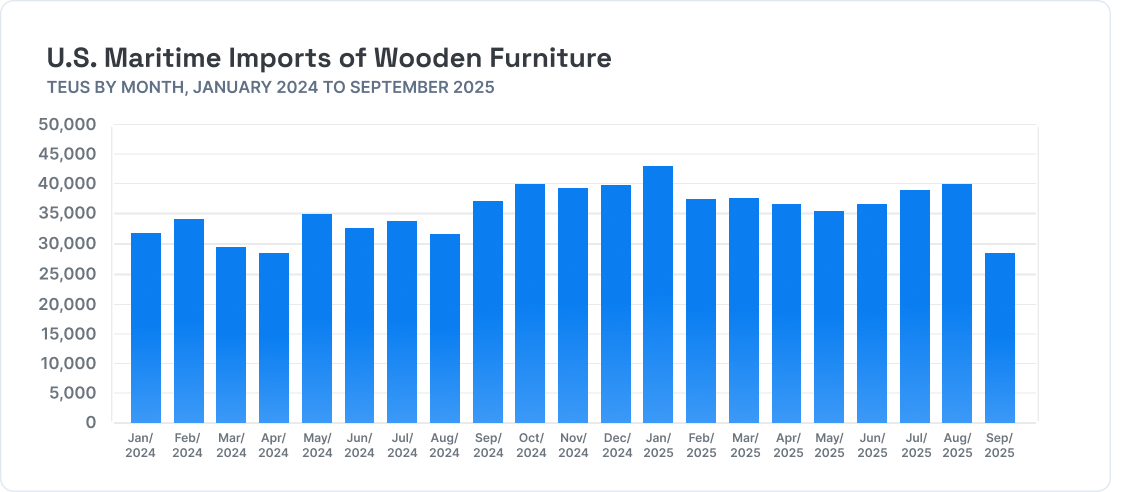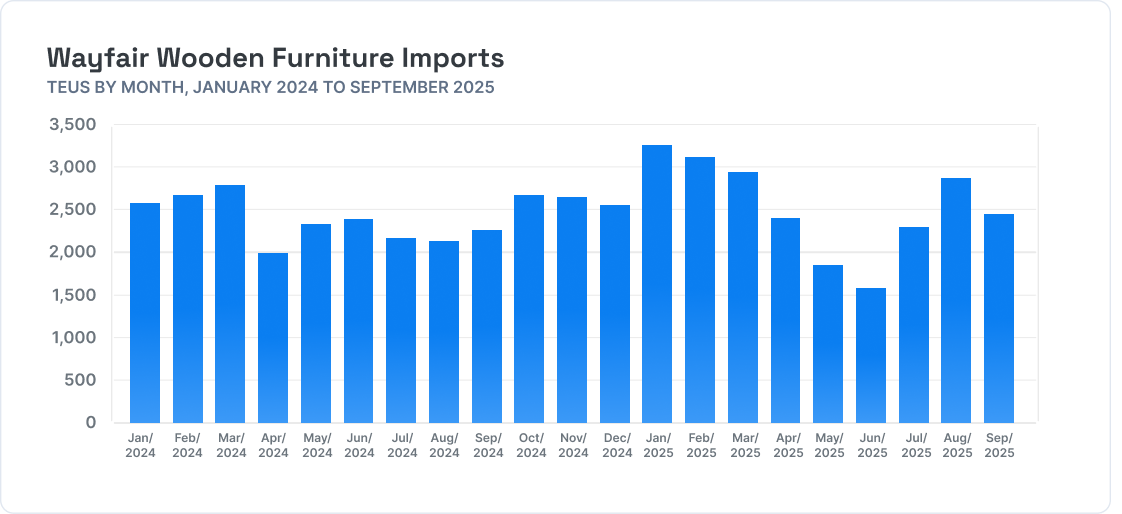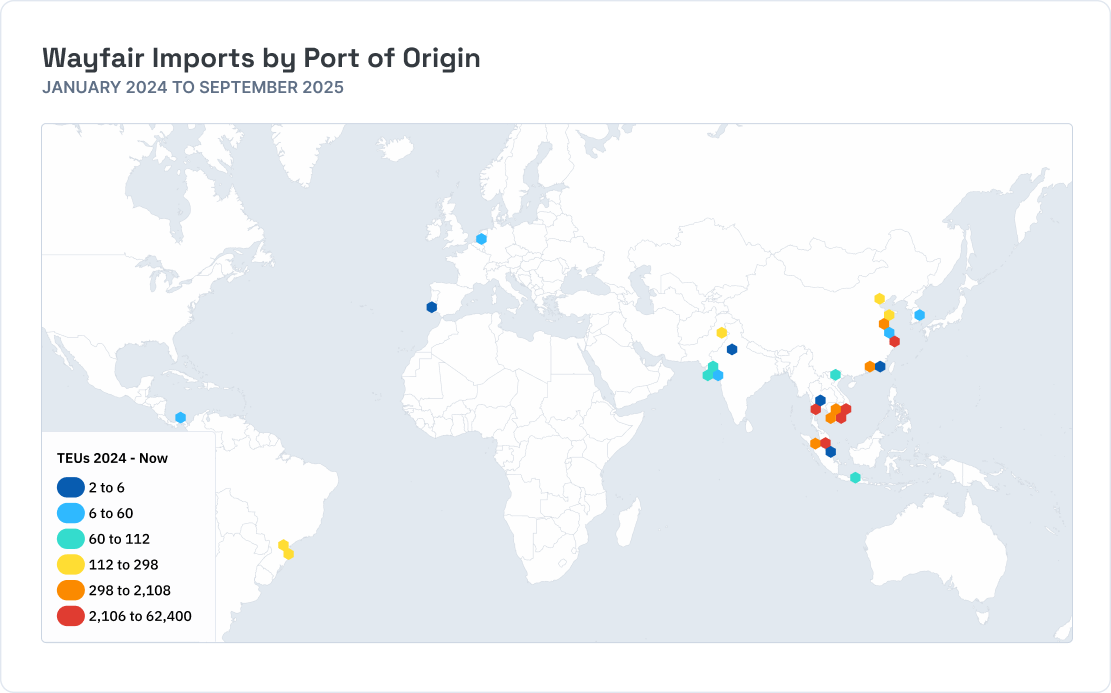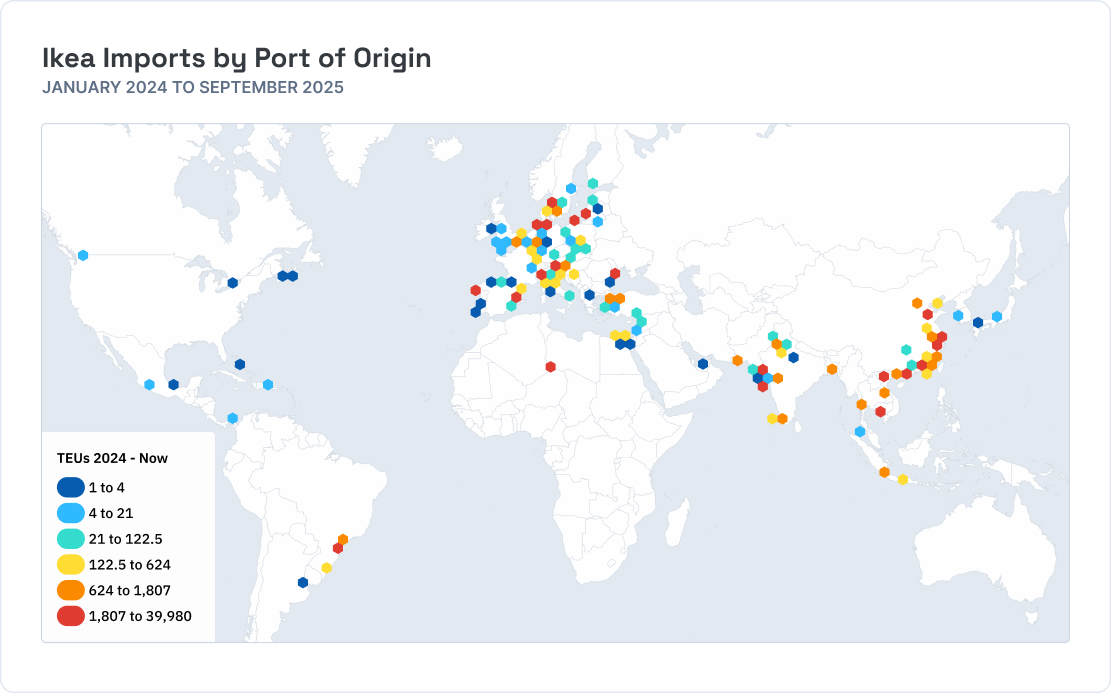For a sector already reeling from a 28% drop in shipments, last week’s new duties on foreign-made wooden furniture could strike a heavy blow
What you’ll learn in this article:
- How U.S. furniture imports dropped precipitously last month.
- Which top retailer’s imports have fallen, and which have weathered the storm.
- How to protect your business from government tariff decisions.
🎯 Best for: Global supply chain managers, VPs of global operations, C-suite executives in the manufacturing sector.
For U.S. furniture retailers already battling soft sales and inflation-weary shoppers, last week’s 25% tariff announcement, aimed directly at the industry, felt like the final nail in the coffee table. A sector already on shaky legs due to earlier tariff rounds now faces another blow, and the data shows it’s hitting hard.
On October 14, the Trump administration introduced new tariffs of 25% on furniture, bathroom vanities and kitchen cabinets — all of which are set to rise on January 1, to 30%, 50% and 50%, respectively. And research conducted by ImportGenius shows that, likely in anticipation of those tariffs, furniture imports to the United States nosedived by 28% in a single month, from 40,272 TEUs in August to 29,085 TEUs in September, their lowest level in 18 months and one of the steepest monthly declines the sector has seen in years.

“Low imports for the furniture sector also mean bad news for the country’s ports,” explains ImportGenius CEO Michael Kanko. “Furniture importers are among U.S. maritime ports’ largest customers. Because of the products’ size and weight, furniture shipping has a disproportionately large impact on freight volumes compared to other goods.”
ImportGenius’ research also shows that some major players in the highly concentrated furniture sector saw large shipment variations earlier in the year, when the Trump administration first began implementing country-specific tariffs — with some growing and others plummeting.
“What’s clear from the data is that the less diversified your supply chain is, the more you are at the mercy of the government’s tariff decisions,” says Kanko. “It’s a lesson that applies to every manufacturing business now.”
Wayfair gets waylaid, while Ikea weathers the storm
As part of its research, ImportGenius examined monthly shipments for a selection of major furniture retailers in the United States since the start of 2024. Wayfair, the Massachusetts-based online retailer with more than $12 billion in annual revenues, has had a roller-coaster 2025 in terms of shipments, from a high of 3,250 TEUs in January to just over 1,500 TEUs — a 50% drop in just six months.

Wayfair’s declining spring imports coincide with the Trump administration’s imposition of higher tariffs on China, which were increased to 54% on April 2, and rose as high as 145% later that month, before settling at 30% on May 12. Notably, mapping the origins of Wayfair’s imports for the two-year period show that the majority came from Southeast Asia.

By contrast, Ikea, the Swedish furniture manufacturer and retailer with 52 locations in the United States, has had a very different 2025, with monthly shipment totals surpassing 10,000 TEUs in March and staying there through August, reaching a high of 13,352 TEUs in May. In a period characterized by uncertainty, Ikea has thrived in the U.S. market.

The port-of-origin map of Ikea’s imports for the period shows substantial volumes coming not only from China but from Europe, India, the Middle East, and South America — a deeply diversified and truly global supply chain that has served the company well.

What’s next, lessons learned — and how you can prepare
While Ikea’s diversified supply chain has benefited the company to date, its impact may become less pronounced because the new 25% tariffs on furniture apply no matter where it is manufactured. But there are always exceptions: some countries’ furniture imports remain subject to lower rates, including those from the United Kingdom (10%), the European Union (15%), and Japan (15%).
“When it comes to tariffs, the focus now is less on specific countries and more on specific products, “ says Kanko. “But the top takeaway from the furniture sector is that there is always an advantage to a properly diversified supply chain.”
The other takeaway from the furniture industry is that just about anything can be manufactured cost-effectively anywhere in the world. “The benefits of a diversified supply chain reach beyond tariff minimization,” says Kanko. “It also creates competition among your suppliers, gives you a leg up on competitors, and gives you lots of options in hard times.” The key to supply chain diversification is information: the ability to locate, investigate, and vet new suppliers overseas.
[CTA]
Explore how leading retailers use ImportGenius data to find new suppliers and stay resilient amid changing trade policy.

Explore how leading retailers use ImportGenius data to find new suppliers and stay resilient amid changing trade policy.



More blogs & reports



.png)

